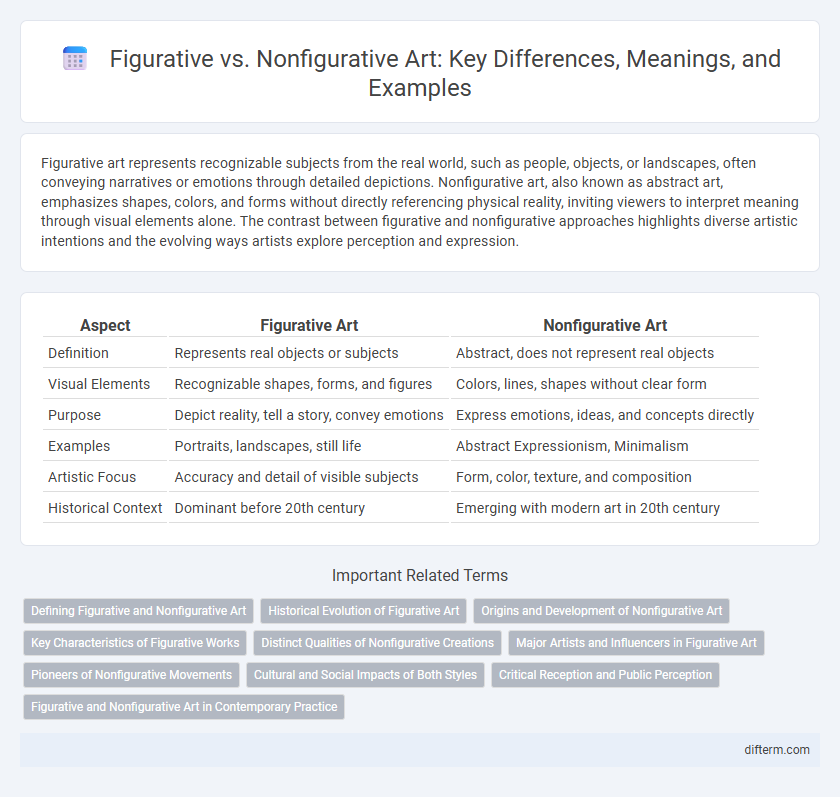Figurative art represents recognizable subjects from the real world, such as people, objects, or landscapes, often conveying narratives or emotions through detailed depictions. Nonfigurative art, also known as abstract art, emphasizes shapes, colors, and forms without directly referencing physical reality, inviting viewers to interpret meaning through visual elements alone. The contrast between figurative and nonfigurative approaches highlights diverse artistic intentions and the evolving ways artists explore perception and expression.
Table of Comparison
| Aspect | Figurative Art | Nonfigurative Art |
|---|---|---|
| Definition | Represents real objects or subjects | Abstract, does not represent real objects |
| Visual Elements | Recognizable shapes, forms, and figures | Colors, lines, shapes without clear form |
| Purpose | Depict reality, tell a story, convey emotions | Express emotions, ideas, and concepts directly |
| Examples | Portraits, landscapes, still life | Abstract Expressionism, Minimalism |
| Artistic Focus | Accuracy and detail of visible subjects | Form, color, texture, and composition |
| Historical Context | Dominant before 20th century | Emerging with modern art in 20th century |
Defining Figurative and Nonfigurative Art
Figurative art represents recognizable objects or subjects from the real world, often emphasizing accurate depiction of human figures, animals, and landscapes. Nonfigurative art, also known as abstract art, eschews identifiable subjects to focus on shapes, colors, and forms conveying emotions or concepts. Understanding the distinction helps viewers interpret artistic intent, distinguishing literal representation from expressive abstraction.
Historical Evolution of Figurative Art
Figurative art traces its origins to prehistoric cave paintings, evolving through classical antiquity with realistic depictions of human forms and mythological subjects. The Renaissance marked a revival of naturalism and anatomical precision, solidifying figurative representation as central to Western art. Over time, shifts toward abstraction and nonfigurative styles challenged traditional figurative norms, yet its historical evolution highlights a continuous dialogue between realism and imaginative expression.
Origins and Development of Nonfigurative Art
Nonfigurative art, also known as abstract art, emerged in the early 20th century as artists like Wassily Kandinsky and Kazimir Malevich sought to break away from traditional representational forms. Rooted in movements such as Cubism and Expressionism, nonfigurative art emphasized color, shape, and composition to evoke emotions and concepts without depicting recognizable subjects. This departure from figurative art marked a significant evolution in artistic expression, prioritizing pure abstraction and visual language over literal representation.
Key Characteristics of Figurative Works
Figurative art emphasizes recognizable forms and subjects, often depicting real-life objects, people, or scenes with a focus on detail and realism. Key characteristics include clear representation, narrative elements, and emotional expressiveness that connect viewers to familiar visual experiences. This contrasts with nonfigurative art, which prioritizes abstract shapes, colors, and forms without direct reference to the physical world.
Distinct Qualities of Nonfigurative Creations
Nonfigurative art emphasizes abstract forms, colors, and textures, creating visual experiences that evoke emotions without depicting recognizable subjects. Its distinct qualities include the exploration of pure artistic elements like line, shape, and composition, allowing for unrestricted interpretation. This approach challenges traditional representation by prioritizing sensory impact over narrative content.
Major Artists and Influencers in Figurative Art
Major artists in figurative art include Lucian Freud, known for his intense, realistic portraits that emphasize human psychology and form, and Alice Neel, whose expressive portraits capture the emotional depth of her subjects. Influencers like Chuck Close revolutionized the genre with his large-scale, photorealistic paintings, pushing the boundaries between abstraction and representation. Their contributions continue to shape contemporary figurative art by emphasizing the human experience through detailed, recognizable imagery.
Pioneers of Nonfigurative Movements
Kazimir Malevich and Wassily Kandinsky emerged as pivotal pioneers of nonfigurative art, championing abstract expression and the liberation from traditional representational forms. Malevich's Suprematism emphasized geometric shapes and pure color to evoke spirituality and emotion beyond physical reality. Kandinsky's theories on color and form revolutionized art by asserting that nonfigurative compositions could convey profound inner experiences and universal truths.
Cultural and Social Impacts of Both Styles
Figurative art, with its recognizable subjects and narratives, often reflects and preserves cultural identity, reinforcing social values and collective memory through visual storytelling. Nonfigurative art challenges societal norms by prioritizing abstract forms and emotional expression, fostering diverse interpretations that stimulate cultural dialogue and social introspection. Both styles contribute to cultural evolution by shaping public perception and influencing community engagement in the arts.
Critical Reception and Public Perception
Figurative art, rooted in recognizable imagery, often garners widespread public appreciation for its accessibility and narrative clarity, receiving favorable critiques for its emotional resonance and technical skill. Nonfigurative art, or abstract art, challenges viewers with its emphasis on form, color, and composition, provoking mixed critical reception that ranges from admiration for its innovation to skepticism regarding its interpretive ambiguity. Public perception of nonfigurative works tends to be polarized, with some audiences valuing its expressive freedom while others struggle to connect without familiar visual references.
Figurative and Nonfigurative Art in Contemporary Practice
Figurative art in contemporary practice emphasizes representational imagery that portrays recognizable subjects, often reflecting cultural narratives and human experiences. Nonfigurative art, or abstract art, prioritizes form, color, and texture over explicit representation, encouraging viewers to interpret meaning through visual elements alone. Together, these approaches expand the boundaries of visual expression, allowing artists to explore identity, emotion, and conceptual frameworks within modern art.
figurative vs nonfigurative Infographic

 difterm.com
difterm.com